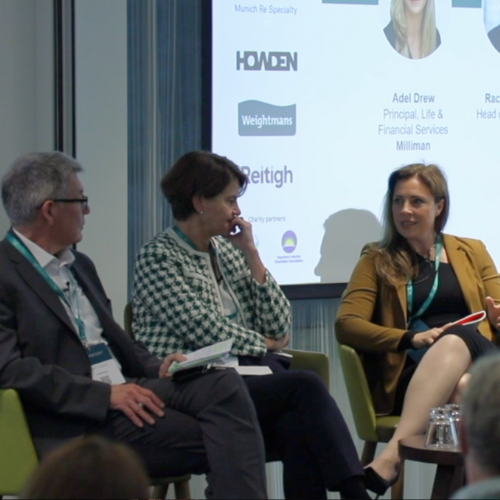- 16 Shrewsbury Road, Redhill, Surrey, RH1 6BH, United Kingdom
- Contact@betterinsurancenetwork.com
Session summary: Building a holistic and actionable view of climate risk
November 8, 2024

Based on insights from the “Future Fit” panel discussion on climate risk at Accelerate Sustainability in London on 1 October.
Climate risk is fast-moving, complex and interconnected. At the recent Accelerate Sustainability conference, experts from Howden, Convex, New England Asset Management and Milliman explored the challenges and approaches to modelling uncertain future scenarios while also building resilience in the face of escalating threats.
“To manage risk, you’ve got to understand it. One of the big challenges now is how to do that when the past is a less reliable predictor of the future,” said moderator Matt Foote, Howden’s Head of Climate Risk Intelligence. “We’ve got to be more creative about how we understand that collectively.”
Climate risks intersect with numerous factors, from energy transition, geopolitical tensions and urbanisation, making future loss impacts difficult to quantify. Climate transition and physical climate impacts will likely drive inflationary pressures, for example, affecting post-catastrophe restorations and the wider supply chain, which may in turn impact claims ratios and insurance affordability, the panel warned.
“It’s not enough to think about climate risk in a vacuum, because we can see the risk landscape is going to be exacerbated by climate, and climate is going to exacerbate existing risks,” said Milliman Principal Adel Drew, while Rachel Delhaise, Convex’s Head of Sustanability, urged “a healthy wariness” of the models currently in use.
A key step is to evolve those models beyond their traditional focus on physical risks to include causal and scenario-based elements, enabling insurers to anticipate potential chain reactions and second-order impacts.
This will help optimise portfolio exposures and performance, as well as building resilience and preparedness among clients, guiding better-informed decisions and mitigating future losses.
“We also need to look for more nuanced models. More local specificity will be increasingly valuable,” Delhaise said. “The insurance world is used to dealing with uncertainty, but it’s clear that with climate change, that uncertainty is increasing.”
Harmonising strategy across underwriting and investments
“In an ideal world, we would love to see risk assessments being conducted across both sides of the balance sheet,” said Kasha Mleko, Head of Sustainability at insurance specialist asset manager NEAM.
As Mleko pointed out, investment risk assessments are often regulation-driven and can be relatively simplistic. “However, there’s a real opportunity to leverage all of the knowledge and focus on the assessment of risk on the underwriting side to see how that also plays out across into the investment portfolio,” she argued.
The same can be true in reverse, with Delhaise highlighting the educational benefits Convex’s impact investment strategy has brought to its underwriting.
Transparency and harmonization of metrics across the business is essential to bridge the gap between insurance and investment stakeholders. To this end, insurers should look at developing granular, localised models while also adopting metrics that align with investment market needs, the panel discussed.
However, aligning long-term climate risks with shorter-tail underwriting and investment portfolios continues to present a structural challenge, Mleko noted.
“P&C investment portfolios tend to be short-dated, often with a duration of two to three years. However, we have to look over a longer-term horizon to try to understand and bake in some of the tipping points we know are coming,” she said.
As Foote put it: “It’s about moving from a disclosure focus to more strategic decision-making over longer-timescales.”
Understanding climate risk to enable the transition
Despite ongoing challenges, insurers and brokers should also consider how to harness their risk expertise to ensure the industry becomes a more active player in the climate transition.
Examples include ramping up impact-driven investments, collaborating on underwriting and financing emerging technologies, and partnering with governments to support large-scale climate adaptation efforts.
“Insurers are starting to take a more nuanced approach to examining climate risks,” said Mleko. “Whereas initially insurers focused on quantifying downside risk and using exclusions or negative screenings to remove those risks from the portfolio, they’re now thinking about how selectively maintaining some of those holdings can help finance the transition, which is good to see.”
A recent report by BCG and Howden highlighted $19 trillion of additional investment is needed by 2030 to support the transition to a Net Zero economy. “One of the major issues is that there’s also a $10 trillion lack of insurance cover – a huge protection gap,” said Foote. “Insurance is necessary to enable that investment in infrastructure to happen.”
If the insurance industry can better understand the risks related to the climate transition, this will in turn build the confidence which is so essential among investors.
“There’s no absolute future pathway, but people have got to be able to show that they have considered all options as credibly as possible, that they understand as well as possible what the impacts are likely to be, and are then able to justify their decisions,” Foote explained.
“We need to represent these complexities and future uncertainties in ways that make better sense to decision-makers so that, ultimately, there can be more confidence in those decisions being made with the uncertainties that exist.”
Copyright © 2023 Better Insurance Network
Follow Us


